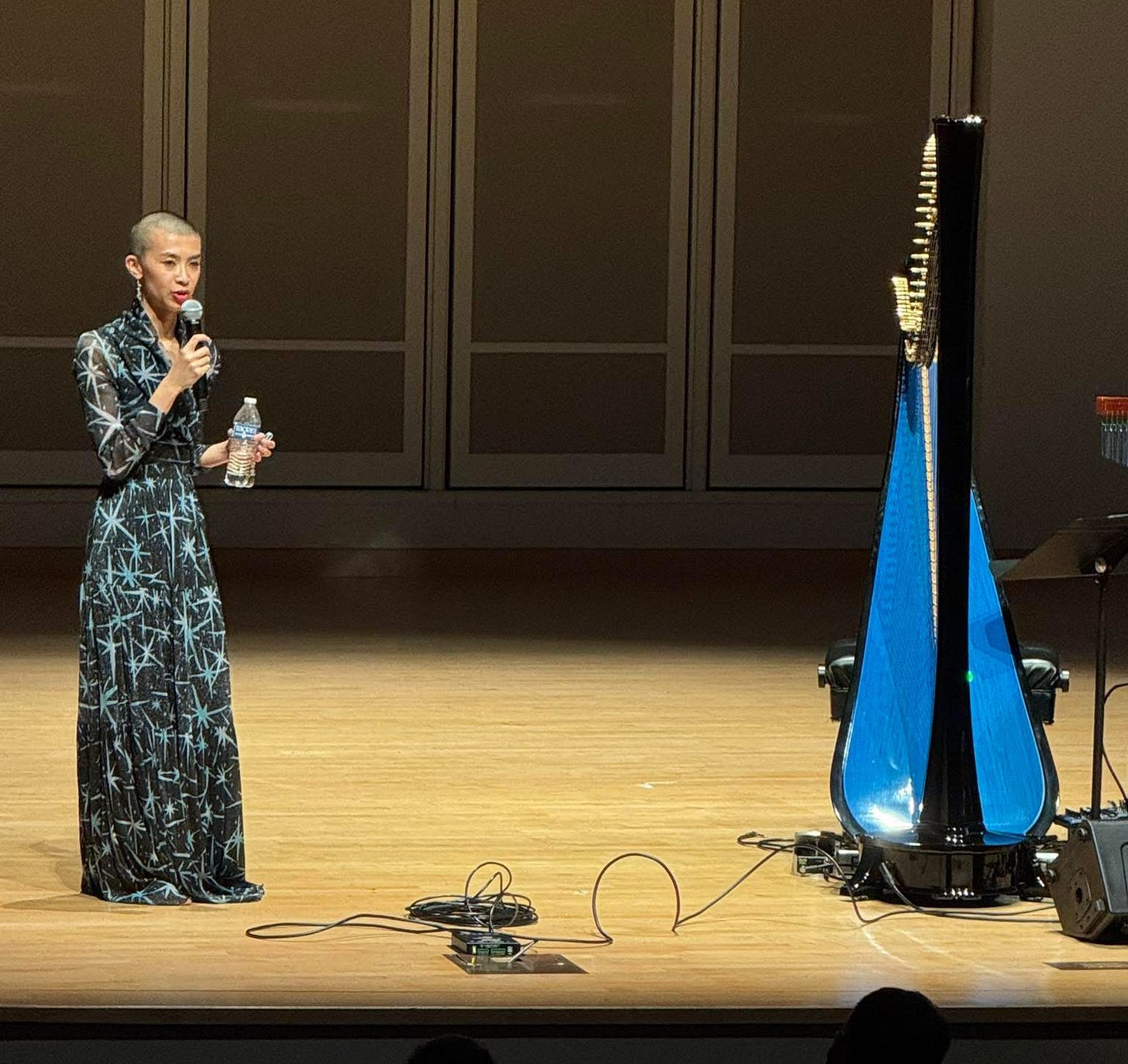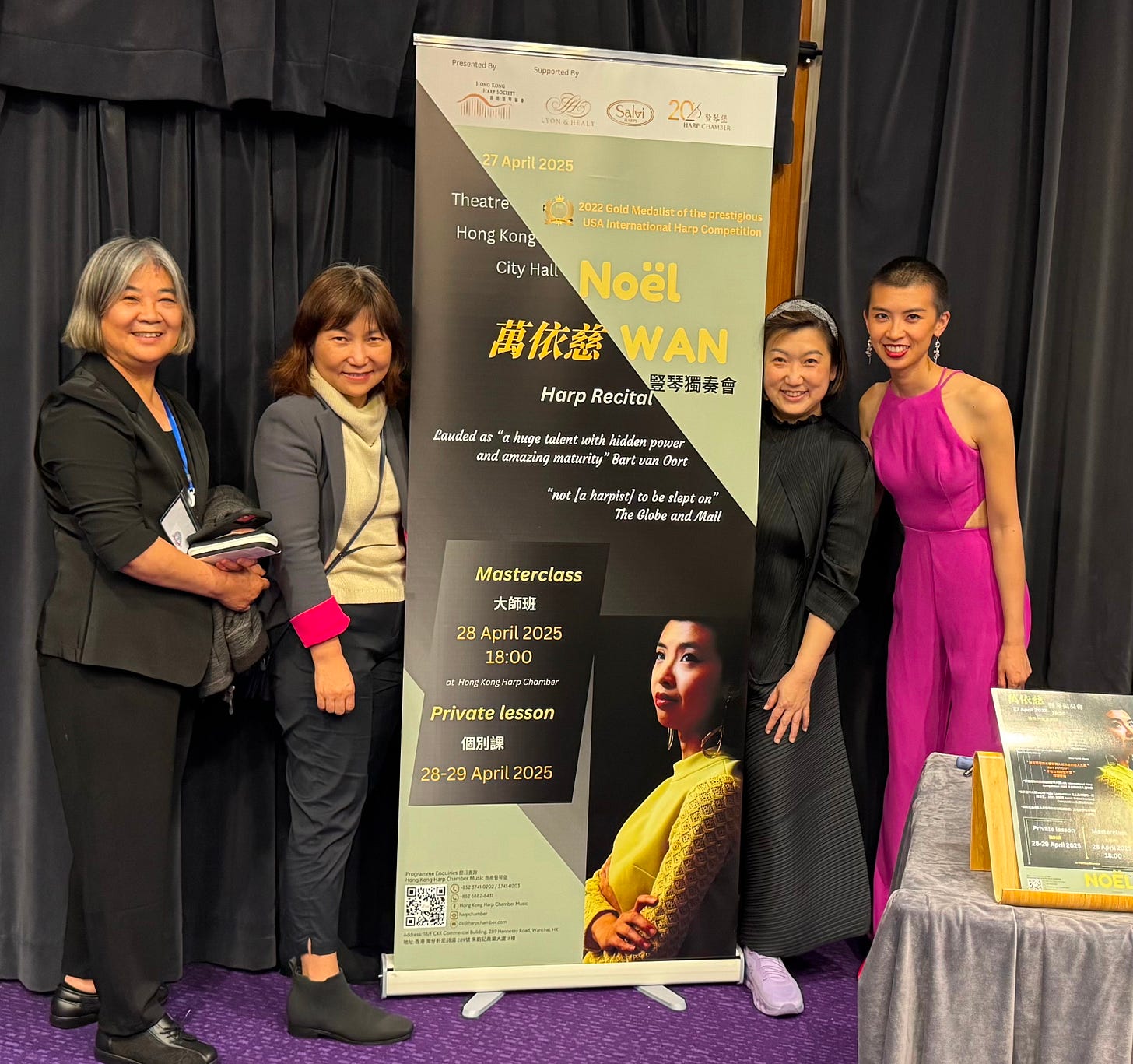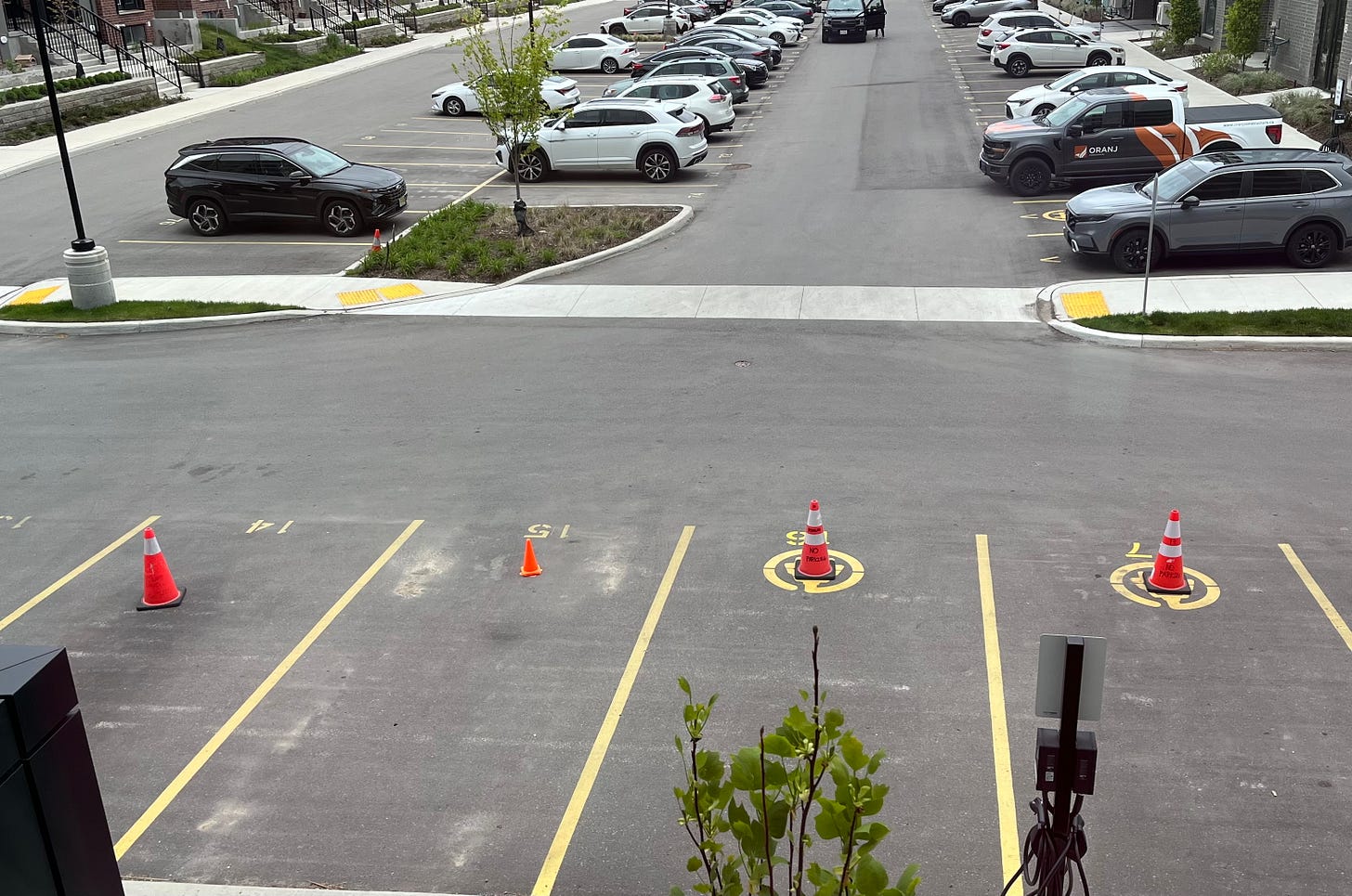Hello, friends, colleagues, and other readers! It has been a while since I last wrote—partly due to feeling very exhausted by the political rollercoaster in the US and not knowing how to articulate the incessant, roiling anxieties, and partly due to just feeling, well, exhausted.
Since January, however, I have been quite busy, and, frankly, not always in a healthy way. Starting in the fall, I’ve decided to give up a few gigs since I will be taking on some exciting new ones that I can’t wait to announce (hopefully in a few months)! In the meantime, I will be working on some new repertoire, including my colleague Cliff Callender’s new solo harp piece Strings and Arches and Caroline Lizotte’s new piece for electroacoustic harp and flute (will be premiered at the World Harp Congress in Toronto next summer!), and weirdly, Salzedo’s Scintillation since I’ve always wanted to learn it.
A list of happenings
Those who follow me on social media have seen me post about Liliya Ugay’s Pull No More, which is a solo electroacoustic harp piece that she wrote for me last year and has been a really interesting process to learn and perform. In addition to our 2 performances in 2024, I took it on the road this year, and it got 5 concert and 2 workshop performances! For now, I’m planning to take a break (no more pull no more🤪), but working on the piece and sharing it with so many different audiences was truly a unique experience. Liliya might even write a Pull No More sequel if we can get funding…
I visited Arizona for the first time in February and gave masterclasses for the lovely Phoenix harp chapter and students in the Mesa Public Schools Harp Program, which is the largest public school harp program in the country (250 students, I think?). Talking to both Charles Lynch, the current MPS harp director, and Karen Miller, the founder of the program, was quite enlightening, especially re: the recent shutdown of the Frisco ISD harp program. Charles said something really salient: he suspected that one of the reasons MPS was still willing to fund the harp program was that his reports to the school district emphasized soft skills (or to use a new phrase I learned recently from this book: human literacy) learned through harp ensemble and lessons, as opposed to “disciplinary excellence” achieved by students in the program (as in, musical achievement). It’s an unfortunately pragmatic way to frame the arts, but hey, you got to learn survival of the best at marketing fittest.
In April, I returned to Phoenix to do a very weird thing: performing on my colleague Tra Bouscaren’s car door harp/sculpture, “The Angel of Death.” Quite frankly, if he had asked me to do this project last year, I would have been paralyzed by incompetence. However, after a year of tinkering on my Camac, I felt maybe 2% more competent to just show up and play a harp strung object that wasn’t tuned in any logical way. In the end, I had a lot of fun playing with sounds, including some neat microtonal tuning peg glissandi and lots of crashing wires. Much of my interest in ambient-ish electronic music is related to wanting to eventually do immersive sound design for installations, so I was very glad to get my toes wet in the company of generous listeners.
After the show in Phoenix, I drove down to Tucson to do some workshops for the AHS Tucson chapter and students at the University of Arizona, led by Carla Fabris who had just won two principal harp positions (New Mexico Philharmonic and Santa Fe Symphony, go Carla!). When I travel, I really enjoy chatting with harpists in different parts of the country, especially to hear them talk about geographical areas of growth (e.g., New Mexico) for harp but also industry and institutional challenges specific to their region.
Another significant event of the semester was premiering my new electroacoustic program “River of Heaven” at FSU (my faculty recitals have turned into a vehicle for testing things). I’d like to talk about “River of Heaven” more in a future post, since I performed it again last week at my laureate recital at the USA International Harp Competition, where it was, much to my surprise, enthusiastically received. Instead, I’ll close with a little recap of my nearly month-long adventure on the road and thank a few people who made it possible:
- The entire Hong Kong/China tour would not have been possible without Angela Yau and the very supportive community of harpists, including Ann Huang who lent me her funky purple Camac for my show in Hong Kong and the electroacoustic harp presentation for the HK Academy for Performing Arts’ composition department. Also many thanks to Salvi Music for sponsoring both my China recitals and the Fuzhou Harp Committee for its generous hospitality during the Salvi Fuzhou Harp Festival. I also got to meet some extended family from my maternal grandfather’s side for the first time; it felt special that my first recital in China was in the province where my grandfather was born.
It seemed common to go out for very lavish seafood hotpot after concerts—even as late as 10 PM! Here are some abalone asserting their agency even as they sit undignified on crushed ice.
- My mom, who, despite being very much a Chinese mom (iykyk), was a total MVP because she helped me apply for my work visas and came with me for the two weeks in Asia.
- My former teacher Ann Yeung also saved my ass by letting me practice in her office while I was homeless (displaced?) for a week and buying food for me. I have many reasons to appreciate her as a mentor; she is also the reason I tell my FSU students now to find professional mentors who will absolutely go to bat for you and be generous with their time and resources.
- My friends Dani (of The Collective) and Ian who let me crash at their house in Urbana for a few days. I spent most of my formative adulthood in Urbana so it’s a special town, but returning to old haunts feels less eerie when you know friends are there, too. The Collective will be releasing a final issue this year before Dani takes it in a different direction with a new editorial team (possibly ft. yours truly!).
- Finally, despite the tornado warnings 30 minutes before my USAIHC concert, we managed to make it happen. Lots of gratitude to the USAIHC staff, including Adaleigh, Deb, and especially Julianne (for listening to my soundchecks), and to Salvi for letting me use a very beautiful blue Electra.

However, as the queen of resigned hot takes, I will add that I’m a little disappointed that the USAIHC Final Round has gone back to being very young (ages 19, 20, and 22), given the large number of older contestants in the pool this edition. Even though I hear a lot of talk of supporting more mature artistry, I have witnessed enough juries—not just in harp competitions—continue to reward flashy, highly technical playing by young musicians. My advice for older musicians on the competition/audition circuit? Don’t give the jury an excuse to knock you down on technical points; if you really want to win, you need to be in superb, if not better, shape than the youngsters (e.g., some kids who play crazy fast don’t always play cleanly or with even tone). It feels incredibly unfair, but it’s the only way to beat the system.
What’s next?
Due to some crazy burnout that started pummelling me last November (as in, literally would start crying spontaneously in the car), I’ve decided to take most of the summer off and live a boring life. Besides a little trip to Philly to give a chamber coaching, I’m planning to R&R&R (rest, relax, read), swim in lovely non-alligator infested Ontario lakes, hike, and enjoy seasonal peaches and Herrlies’ corn this summer.
I will be munching through a massive pile of reading, some of it in preparation for a new course I am co-developing with my musicology colleague Erol Köymen. We’ll be teaching a two-semester sequence on social theory and sound, which means I get to read lots of philosophy and theory, yay! It’ll also be interesting to apply some creative and constructive teaching methods to this course. Social theory is typically very difficult and dry to read, but Erol and I really want students to feel like they understand the world better? differently? at the end of each semester. I’ll still be teaching my entrepreneurship course and cannot wait to get my hands on this new critical (in both senses) history of entrepreneurship by Erik Baker. I don’t think entrepreneurship should be taught uncritically since the concept and economics of it are not without issues; bootstrapping isn’t a solution to deep systemic problems, e.g., exploitative music industry practices, cuts to grants and safety net funding for artists, art music’s overreliance on private wealth, etc.
Finally, I have my grant from the Ontario Arts Council to work on The Mother’s Teeth, which means I will be taking my Camac and my two cats to my in-laws’ cottage to write some music. What currently feels like an abundance of free time will probably disappear quickly, but if it doesn’t, my plan is also to properly learn Max. So, it’ll be a full summer, but hopefully one that will be enriching!
‘til next time,
Noel
The Corner of Wondrous and Powerful
BANKS - Off With Her Head
Patrick and I are not afraid to love pop music and can't stop listening to BANKS’ new album Off With Her Head. To be fair, BANKS isn’t exactly Taylor Swift in terms of mass popularity, and what I have always liked about her music is its dark electronica production (textually, she's not afraid of going for both psychological and body horror). “Guillotine” is, as Patrick keeps telling me, “too short.” Doechii rages hard in “I Hate Your Ex-Girlfriend,” and “Meddle in the Mold” sounds like the catchy foundling of Jean-Paul Sartre and Jessie Reyez.
This summer, I am also getting into all sorts of Gothic-y, monster-y stuff since yes, technically, I’m still researching monstrous feminine sound. Three of my most recent concert programs—“The Birds,” “River of Heaven,” and “before she had freedom, she had dreams”*—have reflected this interest in a) monstrosity and b) subsumption. I can’t stop thinking about the film trope of the archaic mother from Barbara Creed’s book and what her mitotic cannibalism would sound like. As a fully amplified set, “River of Heaven” was just a testing ground for thinking through the idea of being swallowed by sound (oral or aural? Ada or Ardor?).
*I’ve not performed this one outside of FSU. It was a solo/chamber program inspired by the trope of female madness/hysteria as a form of eluding patriarchal capture, and my absolute favorite moment was reciting excerpts of Charlotte Perkins Gilman’s “The Yellow Wallpaper” before segueing into the paper crumpling at the beginning of Angelica Negrón’s Drawings for Meyoko…ugh! so perfect!
Right now, I am reading Jack Halberstam’s Skin Shows: Gothic Horror and the Technology of Monsters while I am waiting for his new book Anarchitecture After Everything (very excited for it after reading this essay). Literary theory can often feel overindulgent, like every intricate puzzle presented by the author is really a try-hard attempt to justify the existence of an entire academic field. However, Halberstam is such a beautiful writer and does offer some curious insights that give me new ideas about genre, gender, and the harp: monster as a metaphor for the novel (i.e., a single literary trope deconstructs an entire literary form) or the popular Gothic novel, especially when written by a man, as a form of transvestism given the strong association between commercially successful literature and women. As in, pulpy or low-brow books were for the casual consumption of ladies—leave the literary masterworks to the big boys.
(Spoiler: Big boys are overrated, truly.)








